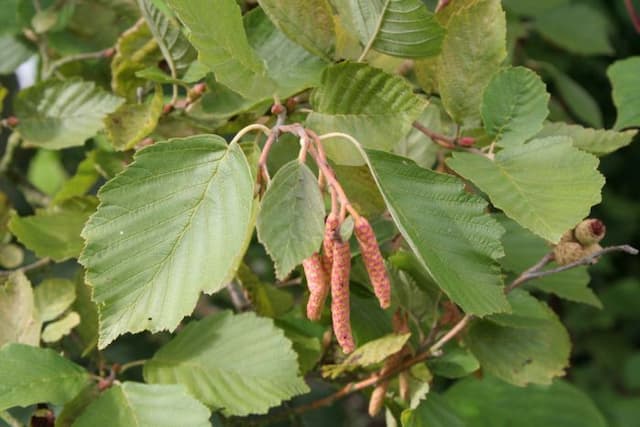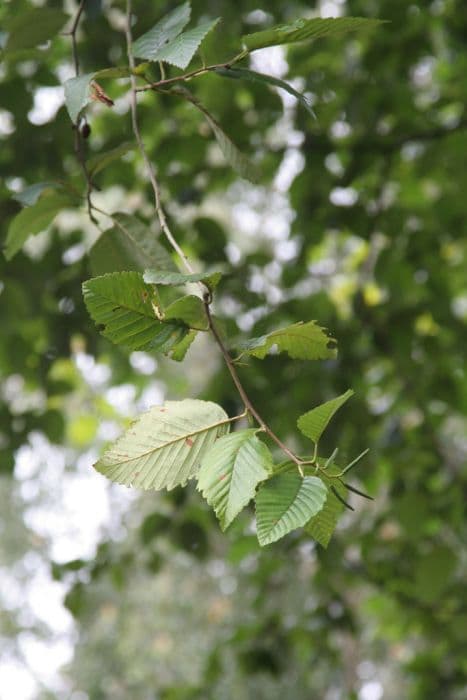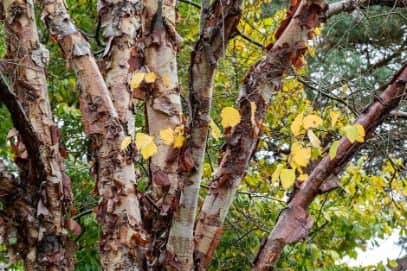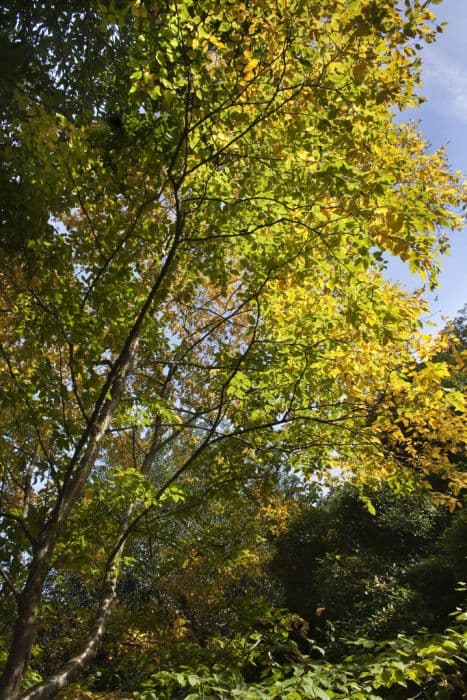Chinese Red Birch Betula utilis subsp. albosinensis 'K. Ashburner'

ABOUT
The plant known commonly as the Chinese red birch is a visually compelling species. It is most renowned for its exquisite bark, which peels away in papery sheets to reveal a rich array of colors beneath; creamy white, pink, and copper hues blend on the surface of the trunk, creating a striking display. The bark's texture is smooth and has a polished look, making it a year-round focal point in the garden. The leaves on this plant are also attractive, with a classic ovate shape that tapers to a point. The foliage adopts a fresh green color during the growing season, providing a lovely contrast to the colorful bark. In the fall, the leaves turn to bright shades of yellow, adding to the plant's overall allure. While flowers are typically not the main highlight, the plant does produce catkins. These flower structures are long and cylindrical, appearing before the leaves fully emerge. The catkins are modest yet add a soft texture to the springtime appearance of the plant. Completing the picture, the branches and twigs are adorned with a slightly glossy skin, which may also peel in a similar fashion to the trunk. Overall, the Chinese red birch presents an alluring combination of color, texture, and form that captivates the senses through every season.
About this plant
 Names
NamesFamily
Betulaceae
Synonyms
Kashmir Birch, Chinese Red Birch
Common names
Betula albosinensis var. septentrionalis, Betula utilis var. albosinensis.
 Toxicity
ToxicityTo humans
The plant commonly known as Chinese red birch is not known to be toxic to humans. Therefore, there are no specific symptoms or consequences associated with the ingestion of this plant by humans.
To pets
The plant commonly known as Chinese red birch is not known to be toxic to pets either. Similarly, there are no specific symptoms or consequences associated with the ingestion of this plant by pets.
 Characteristics
CharacteristicsLife cycle
Perennials
Foliage type
Deciduous
Color of leaves
Green
Flower color
Varies
Height
8 meters (26 feet)
Spread
4 meters (13 feet)
Plant type
Tree
Hardiness zones
7
Native area
China
Benefits
 General Benefits
General Benefits- Ornamental Value: The Betula utilis var. albosinensis 'K. Ashburner', commonly known as Chinese Red Birch, has striking white or pinkish bark that peels in layers, adding visual interest to gardens and landscapes.
- Shade: With its canopy of wide, green leaves, the Chinese Red Birch provides cooling shade during hot summer months.
- Wildlife Habitat: The tree supports wildlife by offering habitat and food with its seeds and catkins, which attract birds and other small animals.
- Seasonal Interest: It presents a year-round visual display - including spring catkins, lush summer foliage, and autumn leaf color changes before revealing its notable bark in winter.
- Erosion Control: The root system can help stabilize soil and prevent erosion on slopes or in areas prone to soil degradation.
- Adaptability: Chinese Red Birch is adaptable to a range of conditions, making it suitable for different landscape settings.
- Low Maintenance: Once established, it generally requires minimal care, making it a suitable choice for gardeners seeking low-maintenance plants.
 Medical Properties
Medical PropertiesThis plant is not used for medical purposes.
 Air-purifying Qualities
Air-purifying QualitiesThis plant is not specifically known for air purifying qualities.
 Other Uses
Other Uses- The peeling bark of Betula utilis (birch) can be used for artistic purposes, like creating natural textures in crafts or as a canvas for rustic artwork.
- Birch wood is popular for woodworking projects due to its strength and smooth grain, making it suitable for furniture making and carving.
- The wood of birch can be used to make musical instruments, including drums and flutes, because of its fine acoustic properties.
- Birch branches may be used in garden landscaping to create natural fencing or as support stakes for climbing plants.
- The sap of birch trees can be tapped and fermented to create birch beer or vinegar.
- Due to its high flammability, birch bark is excellent for starting fires, and it's often used in camping and survival situations as a natural kindling.
- The inner bark of birch can be used as an emergency food source; it has been historically consumed by indigenous peoples in times of scarcity.
- Birch plywood is commonly used in the manufacture of skateboards because of its durability and flexibility.
- Dried birch leaves can create a natural dye for fabric, yielding soft yellow or light green hues.
- The wood of birch trees can be processed into a high-quality charcoal used for drawing and art.
Interesting Facts
 Feng Shui
Feng ShuiThe Birch tree is not used in Feng Shui practice.
 Zodiac Sign Compitability
Zodiac Sign CompitabilityThe Birch tree is not used in astrology practice.
 Plant Symbolism
Plant Symbolism- Adaptability: The Betula utilis subsp. albosinensis 'K. Ashburner', also known as the Chinese Red Birch, often grows in a variety of climates which symbolizes the ability to adapt to different life conditions.
- Purity: Birch trees, in general, are associated with purity due to their bright white bark; this variety, with its slightly different hue, still retains that symbolic connection.
- New beginnings: In various cultures, birch trees signify new beginnings and fresh starts as they are among the first trees to grow back after forest fires.
- Renewal: The peeling bark of the Chinese Red Birch, reveals new layers beneath, symbolizing personal growth and renewal.
- Protection: Historically, birch trees were believed to ward off evil and protect against harm, a symbolic meaning that extends to this subspecies.
 Water
WaterThe Chinese Red Birch should be watered deeply and slowly to ensure the soil is moist but not waterlogged, generally needing about 1 to 1.5 gallons every week during the growing season, depending on the weather conditions. During hot or dry periods, the frequency of watering should be increased to prevent stress, ensuring that the top few inches of soil are consistently moist. In the fall and winter, reduce watering to match the plant’s reduced growth rate, providing enough water to prevent the soil from drying out completely.
 Light
LightThe Chinese Red Birch thrives in full sun to partial shade conditions. It is best positioned in a spot where it can receive at least six hours of direct sunlight each day, with some afternoon shade to protect it during the hottest part of the day in warmer climates.
 Temperature
TemperatureThe Chinese Red Birch can tolerate a range of temperatures; it typically withstands winter lows down to -20°F and can handle summer highs well into the 90s°F. However, the ideal growing temperature for this birch is between 60°F and 70°F. Extreme temperatures should be avoided to maintain the tree's health and vigor.
 Pruning
PruningThe Chinese Red Birch should be pruned to remove any dead or damaged branches and to maintain its desired shape. Pruning is best done in late winter or early spring before new growth starts, typically once a year. Occasional thinning of the canopy can help to increase light and air circulation, promoting the tree's overall health.
 Cleaning
CleaningAs needed
 Soil
SoilChinese Red Birch prefers well-drained, loamy soil with a pH range of 5.5 to 6.5. The ideal soil mix can be composed of equal parts garden soil, compost, and peat moss or leaf mold to ensure good drainage and fertility.
 Repotting
RepottingChinese Red Birch is not typically grown in containers and does not require frequent repotting. It is usually planted directly into the ground.
 Humidity & Misting
Humidity & MistingChinese Red Birch thrives best in average outdoor humidity. It does not have specific humidity requirements, but it can tolerate a range of conditions typical of temperate climates.
 Suitable locations
Suitable locationsIndoor
Not suitable for indoor growth, needs ample space.
Outdoor
Plant in full sun to partial shade, in moist soil.
Hardiness zone
6-9 USDA
 Life cycle
Life cycleThe plant commonly known as the Chinese Red Birch (Betula utilis subsp. albosinensis 'K. Ashburner') begins its life cycle as a seed, which germinates in late spring when soil conditions are moist and temperatures are mild. After germination, it enters the seedling stage, establishing itself with primary leaves and beginning to develop a root system. As it transitions into the sapling stage, the Chinese Red Birch grows rapidly, its trunk begins to thicken, and it develops the peeling, reddish bark characteristic of mature trees. During maturity, the tree reaches its full height and size, produces flowers that are wind-pollinated, and subsequently, develops small winged seeds that disperse to continue the species’ life cycle. It can live for decades, during which it matures and reaches its reproductive peak, producing abundant seeds annually. Finally, after a long life, the Chinese Red Birch will eventually enter into senescence, where growth slows, and it becomes more susceptible to environmental stresses, disease, and decay, leading to its eventual death.
 Propogation
PropogationPropogation time
Late winter to early spring
The Himalayan Birch, specifically the Betula utilis subsp. albosinensis 'K. Ashburner', is most commonly propagated through semi-hardwood cuttings. This technique generally takes place during the late summer. A cutting, which is a section of the stem, is taken from a healthy, mature tree. The best size for a cutting is about 6 to 12 inches long (15 to 30 centimeters), with several leaf nodes present. The lower leaves are removed, and the base of the cutting is dipped in a rooting hormone to encourage root development. The cutting is then inserted into a well-draining potting medium, ensuring at least one or two nodes are below the surface. The potted cutting should be kept in a humid environment with indirect light until roots have established, typically within a few weeks. Regular attention to moisture levels is crucial during this period to ensure successful propagation.









